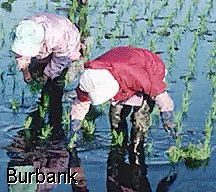
| |
 |
![]()
 Copyright 1997 Alan T. Hagan. All rights reserved.
Copyright 1997 Alan T. Hagan. All rights reserved.
Republished in part by express permission. Please note Disclaimer below.
Entire text also available as an ftp download.
Rice is the single most commonly consumed food grain in the world. The U.S. is the leading exporter of it, though we actually only produce about 1% of the global supply. It is my favorite grain and in the form of brown rice, we eat a great deal of it here at the House.
Much like wheat and corn, rice comes in a number of varieties, each with different characteristics. They are typically divided into classes by the length of their kernel grains; short, medium and long.
- Short Grain Rice
- Short grain rice is a little softer and bit moister when it cooks and tends to stick together more than the longer rices. It has a sweeter, somewhat stronger flavor than long grain rice.
- Medium Grain Rice
- Medium grain rice is not very common in this country. It has flavor like short grain rice, but with a texture more like long grain rice.
- Long Grain Rice
- Long grain rice cooks up into a dryer, flakier dish than the shorter grains and the flavor tends to be blander. It is the most commonly found size of rice on the grocery shelves.
Each of these may be processed into brown, white, parboiled or converted and instant rices. Below is a short discussion of the differences between the various types of rices.
- Brown Rice
- This is whole grain rice with only the hull removed. It retains all of the nutrition to be found in rice and has a pleasant nutty flavor when boiled. From a nutrition standpoint it is by far the best of the rices to put into storage, but it has one flaw: The essential oil in the germ of the rice is very susceptible to oxidation and soon goes rancid. As a result, brown rice has a shelf life of only about six months from the date of purchase unless given special packaging or storage processing. Freezing or refrigeration will greatly extend its storage life. It's also possible to purchase brown rice from long term food suppliers specially packaged in air tight containers with an inert nitrogen atmosphere. In this kind of packaging, (if properly done), the storage life of brown rice can be extended for years.
- Converted Rice
- Converted rice starts as brown rice which undergoes a process of soaking and steaming until it is partially cooked. It is dried and then polished to remove the bran and germ. The steaming process drives some of the vitamins and minerals from the outer layers into the white inner layers. This makes it more nutritious than polished white rice, but also makes it more expensive.
- White Rice
- This is raw rice that has had its outer layers milled off, taking with it about 10% of its protein, 85% of its fat and 70% of its mineral content. Because so much of the nutrition of the rice is lost, white rice sold in this country has to be enriched with vitamins to partially replace what was removed.
DISCLAIMER: Safe and effective food storage requires attention to detail and proper equipment and ingredients. The author makes no warranties and assumes no responsibility for errors or omissions in the text, or damages resulting from the use or misuse of information contained herein. Placement of or access to this work on this or any other site does not mean the author espouses or adopts any political, philosophical or meta-physical concepts that may also be expressed wherever this work appears.